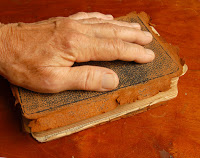The classic courtroom image portrays a witness standing in the dock, right hand raised and left hand resting gently on the Bible. The witness is then asked: “Do you solemnly swear to tell the truth, the whole truth, and nothing but the truth, so help you God?”

Holding a religiously significant object while taking an oath is actually discussed in the Talmud: “Raba said: A judge who adjures by ‘the Lord God of heaven’ [without handing a sacred object to the person taking the oath] is counted as having erred in the ruling of a Mishnah, and must repeat [the procedure correctly]…The oath [must be taken] standing; a disciple of the wise [may take it] sitting. The oath must be administered with a Torah scroll, a disciple of the wise may directly take it with tefillin (phylactaries)” (Talmud Shevuot 38b -39a).
The actual physical act associated with taking an oath goes all the way back to Abraham, as scripture reports: “And Abraham said to his servant [Eliezer]…‘Please place your hand under my thigh. And I will adjure you by the Lord, the God of the heaven and the God of the earth…’” (Genesis 24:2-3).
Even the requirement to raise one’s right hand has a Biblical source: “Whose mouth speaks falsehood, and their right hand is a right hand of lying” (Psalms 144:8).
It should be noted that the requirement of holding a Torah scroll while reciting an oath does not apply to secular court cases.
It is also important to note that swearing is no simple matter in Jewish law. According the halacha, the penalty for breaking an oath is lashes. For this reason, it is important to refrain from swearing whenever possible. In court or in other legal situations, one should rather “affirm” than swear, a subject to be dealt with in a future Jewish Treat).
Copyright © 2012 National Jewish Outreach Program. All rights reserved.
If you like what you’ve read here, signup to get notifications about new treats.
Related Posts
Hand In
If you have extra time, volunteer at a local organization that helps those less…
0 Comments1 Minute
 Print This Page
Print This Page